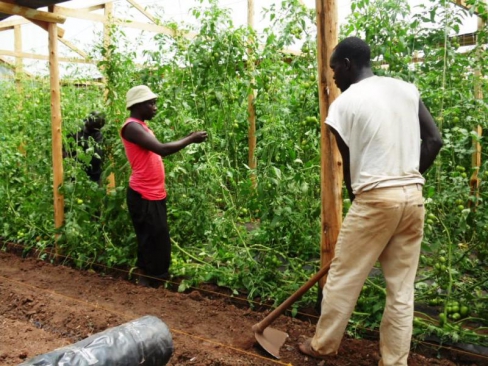
Like most young hustlers, Darius Cheruiyot of Silibwet, Bomet County has tried his hand in almost everything, from being a mechanic to a driver and a boda boda man. But none of those ventures given him satisfaction like farming.
The 36-year-old tomato farmer shares with Smart Harvest his journey as a greenhouse tomato farmer.
"The idea of setting up a greenhouse for tomatoes came to mind towards the end of 2012 after a visit a cousin's farm. I was impressed by what I saw," Cheruiyot says.
He decided to try the green house because, at one point, he had attempted planting tomatoes in the open but he suffered losses because the crops were attacked by pests and diseases.
To set up a greenhouse, he had to sell his motor bike at Sh55,000.
READ MORE
Miraa farmers push for value addition over market woes
Sh140M fish plant launched in Homa Bay for EU export market
What it will take to produce 'clean milk'
New deal to boost sustainable farming in Africa and the Americas
"My family gave me another Sh25,000 which I combined with the motor bike money to get a green house. I also bought polythene and drip pipes that I used in the greenhouse," he says.
After getting the dimensions from the local agriculture office, Cheruiyot embarked on building his greenhouse.
He constructed a 17m by 13m greenhouse that accommodates 1,200 plants.
In early 2013, he planted his first crop of tomatoes and though he did not get it right at first, he has not looked back because the returns were encouraging.
"I had not spaced my first tomatoes well and they grew too tall, but produced less fruits. I also realised that I was using too much fertiliser, which dented my finances and I had to do something," Cheruiyot says.
And before planting his next crop, he ensured he had applied enough manure from the family dairy unit. He got enough decayed cow dung and mixed it well with the soil in the greenhouse before planting the tomatoes.
"The manure saved me the cost of applying too much chemical fertiliser. For manure, I use foliar that I apply every fortnight," he says.
From the greenhouse, Cheruiyot says he gets an approximate of Sh200,000 during the four months that he harvests his tomatoes. He picks his tomatoes every two days, and sells a crate for between Sh1,500 to Sh2,000.
Most of his clients come to his farm to pick the tomatoes, which they later sell in the nearby Bomet, Libwet, Tenwek markets.
For farmers interested in venturing into this kind of project for profit, Cheruiyot says one has to get the basics right.
"First, tomatoes like a nice warm area in full sun, and need at least eight hours of sunlight a day, or they will produce little mature fruit. The soil should have a pH of 5.5 - 6.8, be fertile, deep, well-drained, and rich in organic matter."
Another magic trick is that Cheruiyot adopted the use of rabbit urine that he applies before his tomatoes reach the flowering stage.
His other magic trick? "I apply rabbit urine on my tomatoes before they reach the flowering stage. Rabbit urine encourages vegetative growth while at the same time, keeps the crop free from common pests."
Like all other farming initiatives, farming has its challenges.
First, his seedlings dried immediately after he had transplanted them.
"To counter this, I started planting the seeds directly in the greenhouse instead of growing them first in a nursery bed," he says.
Cheruiyot says growing tomatoes in a greenhouse might sound appealing, but a lot of work and sacrifice goes into it.
He singles out the diseases and pests that demand that one uses chemicals regularly. These cost a lot and any slight mistake, a farmer ends up losing everything.
He also advises upcoming farmers who want to establish greenhouses to ensure there is a constant supply of water.
Treated water is not good for irrigation if used directly, but if left in an open tank for at least 24 hours, the chlorine disappears thus making it safe to use on crops.
Cheruiyot has started lining the beds where he grows the tomatoes with a polythene sheet that helps conserve the water while at the same time removes the need for weeding because the sheet does not allow weeds to grow.

